Feasibility and Challenges for Vehicle-to-Grid in Electricity Market: A Review
Abstract
1. Introduction
- A V2G technology’s business scheme framework that enables multiple entities to benefit and its feasibility with respect to the electricity market are analyzed.
- Various classifications of V2G technology’s application scenarios are presented, and global V2G technology’s real-world use cases are surveyed, which serves to validate the feasibility of V2G technology.
- The challenges faced by V2G technology at present are categorized into the technical, economical, and social aspects.
2. V2G Business Schemes: Concept and Framework
2.1. Concept
2.2. Framework
3. Feasibility in the Electricity Market
3.1. Peak-to-Valley Arbitrage
3.2. The Spot Market
3.3. DR
3.4. Ancillary Services
3.4.1. Frequency Regulation
3.4.2. Voltage Regulation
3.4.3. Spinning Reserve
3.4.4. Black Start
4. Application Scenarios and Real-World Use Cases
4.1. Application Scenarios
4.1.1. Taxonomy I: Classification by Location
4.1.2. Taxonomy II: Classification by Participation Mode
4.2. Real-World Use Cases
5. Challenges
5.1. Technical: Communication Complexity and Battery Degradation
5.2. Economical: High Fixed Investment and Uncertain Market Policies
5.3. Social: Trust Issue and Range Anxiety
6. Conclusions
- The transition from fuel-powered vehicles to EVs is an inevitable trend. As a means of interaction between EVs and the power grid, V2G technology is essential for the development of EVs and ensuring grid security and stability.
- The concept of V2G technology is introduced by analyzing a specific microgrid containing V2G technology. The exploration of V2G technology’s business schemes indicates broad market prospects and practical economic viability.
- The feasibility of various V2G technology’s services with respect to the electricity market are explored, including peak-to-valley arbitrage, the spot market, DR, frequency regulation, voltage regulation, spinning reserve, and black start.
- A detailed classification of V2G technology’s application scenarios is investigated. Additionally, analysis and discussion of real-world V2G technology’s cases worldwide are presented.
- An overview of the challenges facing by V2G technology’s business schemes is investigated, which mainly from three perspectives: technical, economical, and social. These challenges need to be further studied and overcome.
Author Contributions
Funding
Institutional Review Board Statement
Informed Consent Statement
Data Availability Statement
Conflicts of Interest
Abbreviations
| V2G | Vehicle-to-Grid |
| EVs | Electric vehicles |
| DR | Demand-response |
| RERs | Renewable energy resources |
| BEVs | Battery electric vehicles |
| PHEVs | Plug-in hybrid electric vehicles |
| HEVs | Hybrid electric vehicles |
| FCEVs | Fuel cell electric vehicles |
| VPPs | Virtual power plants |
| IEA | International energy agency |
| TOU | Time-of-use |
| CPs | Charging piles |
| CSs | Charging stations |
| OBC | Onboard charger |
| ISO | International Organization for Standardization |
| V2H | Vehicle-to-Home |
References
- BP Global. Statistical Review of World Energy 2023; Technical Report; Energy Institute: London, UK, 2023. [Google Scholar]
- Panwar, N.L.; Kaushik, S.C.; Kothari, S. Role of renewable energy sources in environmental protection: A review. Renew. Sustain. Energy Rev. 2011, 15, 1513–1524. [Google Scholar] [CrossRef]
- Dincer, I. Renewable energy and sustainable development: A crucial review. Renew. Sustain. Energy Rev. 2000, 4, 157–175. [Google Scholar] [CrossRef]
- Moriarty, P.; Honnery, D. What is the global potential for renewable energy? Renew. Sustain. Energy Rev. 2012, 16, 244–252. [Google Scholar] [CrossRef]
- Motyka, M.W. Global Electricity Review 2023; Technical Report; Ember: Hong Kong, China, 2023. [Google Scholar]
- Sovacool, B.K.; Noel, L.; Axsen, J.; Kempton, W. The neglected social dimensions to a vehicle-to-grid (V2G) transition: A critical and systematic review. Environ. Res. Lett. 2018, 13, 013001. [Google Scholar] [CrossRef]
- Noori, M.; Zhao, Y.; Onat, N.C.; Gardner, S.; Tatari, O. Light-duty electric vehicles to improve the integrity of the electricity grid through Vehicle-to-Grid technology: Analysis of regional net revenue and emissions savings. Appl. Energy 2016, 168, 146–158. [Google Scholar] [CrossRef]
- Hannan, M.; Hoque, M.; Mohamed, A.; Ayob, A. Review of energy storage systems for electric vehicle applications: Issues and challenges. Renew. Sustain. Energy Rev. 2017, 69, 771–789. [Google Scholar] [CrossRef]
- Dik, A.; Omer, S.; Boukhanouf, R. Electric Vehicles: V2G for Rapid, Safe, and Green EV Penetration. Energies 2022, 15, 803. [Google Scholar] [CrossRef]
- International Energy Agency. Global Electric Car Stock, 2010–2022. 2023. Available online: https://www.iea.org/data-and-statistics/charts/global-electric-car-stock-2010-2022 (accessed on 5 April 2023).
- Yu, H.; Xu, C.; Wang, W.; Geng, G.; Jiang, Q. Communication-Free Distributed Charging Control for Electric Vehicle Group. arXiv 2023, arXiv:2306.13154. [Google Scholar] [CrossRef]
- Yilmaz, M.; Krein, P.T. Review of the Impact of Vehicle-to-Grid Technologies on Distribution Systems and Utility Interfaces. IEEE Trans. Power Electron. 2013, 28, 5673–5689. [Google Scholar] [CrossRef]
- Kempton, W.; Letendre, S.E. Electric vehicles as a new power source for electric utilities. Transp. Res. Part D—Transp. Environ. 1997, 2, 157–175. [Google Scholar] [CrossRef]
- Pearre, N.S.; Kempton, W.; Guensler, R.L.; Elango, V.V. Electric vehicles: How much range is required for a day’s driving? Transp. Res. Part C—Emerg. Technol. 2011, 19, 1171–1184. [Google Scholar] [CrossRef]
- Tan, K.M.; Ramachandaramurthy, V.K.; Yong, J.Y. Integration of electric vehicles in smart grid: A review on vehicle to grid technologies and optimization techniques. Renew. Sustain. Energy Rev. 2016, 53, 720–732. [Google Scholar] [CrossRef]
- Høj, J.C.M.L.; Juhl, L.T.; Lindegaard, S.B. V2G—An Economic Gamechanger in E-Mobility? World Electr. Veh. J. 2018, 9, 35. [Google Scholar] [CrossRef]
- Shafie-khah, M.; Neyestani, N.; Damavandi, M.; Gil, F.; Catalão, J. Economic and technical aspects of plug-in electric vehicles in electricity markets. Renew. Sustain. Energy Rev. 2016, 53, 1168–1177. [Google Scholar] [CrossRef]
- Kempton, W.; Tomić, J. Vehicle-to-grid power fundamentals: Calculating capacity and net revenue. J. Power Sources 2005, 144, 268–279. [Google Scholar] [CrossRef]
- Bibak, B.; Tekiner-Moğulkoç, H. A comprehensive analysis of Vehicle to Grid (V2G) systems and scholarly literature on the application of such systems. Renew. Energy Focus 2021, 36, 1–20. [Google Scholar] [CrossRef]
- Sovacool, B.K.; Kester, J.; Noel, L.; de Rubens, G.Z. Actors, business models, and innovation activity systems for vehicle-to-grid (V2G) technology: A comprehensive review. Renew. Sustain. Energy Rev. 2020, 131, 109963. [Google Scholar] [CrossRef]
- Geissdoerfer, M.; Pieroni, M.P.; Pigosso, D.C.; Soufani, K. Circular business models: A review. J. Clean. Prod. 2020, 277, 123741. [Google Scholar] [CrossRef]
- Zagrajek, K.; Paska, J.; Sosnowski, Ł.; Gobosz, K.; Wróblewski, K. Framework for the Introduction of Vehicle-to-Grid Technology into the Polish Electricity Market. Energies 2021, 14, 3673. [Google Scholar] [CrossRef]
- Corinaldesi, C.; Lettner, G.; Schwabeneder, D.; Ajanovic, A.; Auer, H. Impact of Different Charging Strategies for Electric Vehicles in an Austrian Office Site. Energies 2020, 13, 5858. [Google Scholar] [CrossRef]
- Inci, M.; Savrun, M.M.; Çelik, Ö. Integrating electric vehicles as virtual power plants: A comprehensive review on vehicle-to-grid (V2G) concepts, interface topologies, marketing and future prospects. J. Energy Storage 2022, 55, 105579. [Google Scholar] [CrossRef]
- Yang, X.; Zhang, Y. A comprehensive review on electric vehicles integrated in virtual power plants. Sustain. Energy Technol. Assess. 2021, 48, 101678. [Google Scholar] [CrossRef]
- Qin, Y.; Rao, Y.; Xu, Z.; Lin, X.; Cui, K.; Du, J.; Ouyang, M. Toward flexibility of user side in China: Virtual power plant (VPP) and vehicle-to-grid (V2G) interaction. eTransportation 2023, 18, 100291. [Google Scholar] [CrossRef]
- IMARC Group. Vehicle-to-Grid Market: Global Industry Trends, Share, Size, Growth, Opportunity and Forecast 2023–2028; IMARC Group: Noida, India, 2023. [Google Scholar]
- Gümrükcü, E.; Klemets, J.R.A.; Suul, J.A.; Ponci, F.; Monti, A. Decentralized Energy Management Concept for Urban Charging Hubs with Multiple V2G Aggregators. IEEE Trans. Transp. Electrif. 2023, 9, 2367–2381. [Google Scholar] [CrossRef]
- Peng, C.; Zou, J.; Lian, L.; Li, L. An optimal dispatching strategy for V2G aggregator participating in supplementary frequency regulation considering EV driving demand and aggregator’s benefits. Appl. Energy 2017, 190, 591–599. [Google Scholar] [CrossRef]
- Hidrue, M.K.; Parsons, G.R. Is there a near-term market for vehicle-to-grid electric vehicles? Appl. Energy 2015, 151, 67–76. [Google Scholar] [CrossRef]
- Bañol Arias, N.; Hashemi, S.; Andersen, P.B.; Treholt, C.; Romero, R. Assessment of economic benefits for EV owners participating in the primary frequency regulation markets. Int. J. Electr. Power Energy Syst. 2020, 120, 105985. [Google Scholar] [CrossRef]
- Kern, T.; Dossow, P.; Morlock, E. Revenue opportunities by integrating combined vehicle-to-home and vehicle-to-grid applications in smart homes. Appl. Energy 2022, 307, 118187. [Google Scholar] [CrossRef]
- Tepe, B.; Figgener, J.; Englberger, S.; Sauer, D.U.; Jossen, A.; Hesse, H. Optimal pool composition of commercial electric vehicles in V2G fleet operation of various electricity markets. Appl. Energy 2022, 308, 118351. [Google Scholar] [CrossRef]
- Yu, H.; Zhang, J.; Ma, J.; Chen, C.; Geng, G.; Jiang, Q. Privacy-preserving demand response of aggregated residential load. Appl. Energy 2023, 339, 121018. [Google Scholar] [CrossRef]
- Wu, W.; Lin, B. Benefits of electric vehicles integrating into power grid. Energy 2021, 224, 120108. [Google Scholar] [CrossRef]
- Liu, W.; Geng, G.; Jiang, Q.; Fan, H.; Yu, J. Model-Free Fast Frequency Control Support with Energy Storage System. IEEE Trans. Power Syst. 2020, 35, 3078–3086. [Google Scholar] [CrossRef]
- Wang, R.; Zhao, Y.; Ma, F.; Gong, Y.; Geng, G.; Jiang, Q. Operational bottleneck analysis and energy storage demand evaluation for high proportion of renewable energy consumption in receiving-end grid. Power Syst. Technol. 2022, 46, 3777–3787. (In Chinese) [Google Scholar]
- Romero-Cadaval, E.; Barrero-González, F.; González-Romera, E.; Milanés-Montero, M.I. Using Plug-in Electric Vehicles to Implement Ancillary Services in Smart Distribution Grids. In Plug in Electric Vehicles in Smart Grids: Integration Techniques; Springer: Singapore, 2015; pp. 309–349. [Google Scholar]
- Wang, Z.; Wang, S. Grid Power Peak Shaving and Valley Filling Using Vehicle-to-Grid Systems. IEEE Trans. Power Deliv. 2013, 28, 1822–1829. [Google Scholar] [CrossRef]
- Nicolson, M.L.; Fell, M.J.; Huebner, G.M. Consumer demand for time of use electricity tariffs: A systematized review of the empirical evidence. Renew. Sustain. Energy Rev. 2018, 97, 276–289. [Google Scholar] [CrossRef]
- State Grid. State Grid Zhejiang Electric Power Co., Ltd. On December 2023 Agent Industrial and Commercial Users of Electricity Purchase Price Announcement. 2023. Available online: https://www.zj.sgcc.com.cn/p1/djmljsfbz.html (accessed on 27 November 2023).
- Zheng, Y.; Shao, Z.; Shang, Y.; Jian, L. Modeling the temporal and economic feasibility of electric vehicles providing vehicle-to-grid services in the electricity market under different charging scenarios. J. Energy Storage 2023, 68, 107579. [Google Scholar] [CrossRef]
- Shi, L.; Guo, M. An economic evaluation of electric vehicles balancing grid load fluctuation, new perspective on electrochemical energy storage alternative. J. Energy Storage 2023, 68, 107801. [Google Scholar] [CrossRef]
- Chen, J.; Zhang, Y.; Li, X.; Sun, B.; Liao, Q.; Tao, Y.; Wang, Z. Strategic integration of vehicle-to-home system with home distributed photovoltaic power generation in Shanghai. Appl. Energy 2020, 263, 114603. [Google Scholar] [CrossRef]
- Tepe, B.; Figgener, J.; Englberger, S.; Jossen, A.; Uwe Sauer, D.; Hesse, H. Analysis of optimally composed EV pools for the aggregated provision of frequency containment reserve and energy arbitrage trading. In Proceedings of the 5th E-Mobility Power System Integration Symposium (EMOB 2021), Hybrid Conference, Germany, 27 September 2021; Volume 2021, pp. 175–180. [Google Scholar]
- Sarker, M.R.; Olsen, D.J.; Ortega-Vazquez, M.A. Co-Optimization of Distribution Transformer Aging and Energy Arbitrage Using Electric Vehicles. IEEE Trans. Smart Grid 2017, 8, 2712–2722. [Google Scholar] [CrossRef]
- Jin, Y.; Yu, B.; Seo, M.; Han, S. Optimal Aggregation Design for Massive V2G Participation in Energy Market. IEEE Access 2020, 8, 211794–211808. [Google Scholar] [CrossRef]
- Illing, B.; Warweg, O. Achievable revenues for electric vehicles according to current and future energy market conditions. In Proceedings of the 2016 13th International Conference on the European Energy Market (EEM), Porto, Portugal, 6–9 June 2016; pp. 1–5. [Google Scholar]
- Huang, J.; Duan, W.; Li, M.; Chen, Y.; Xie, B. Quotation strategy for electric vehicle aggregators in electricity spot market. Electr. Eng. 2023, 1–11. [Google Scholar] [CrossRef]
- Diaz, C.; Mazza, A.; Ruiz, F.; Patino, D.; Chicco, G. Understanding Model Predictive Control for Electric Vehicle Charging Dispatch. In Proceedings of the 2018 53rd International Universities Power Engineering Conference (UPEC), Glasgow, UK, 4–7 September 2018; pp. 1–6. [Google Scholar]
- Song, M.; Amelin, M.; Wang, X.; Saleem, A. Planning and Operation Models for EV Sharing Community in Spot and Balancing Market. IEEE Trans. Smart Grid 2019, 10, 6248–6258. [Google Scholar] [CrossRef]
- Hanemann, P.; Bruckner, T. Effects of electric vehicles on the spot market price. Energy 2018, 162, 255–266. [Google Scholar] [CrossRef]
- Lei, X.; Shang, Y.; Shao, Z.; Jia, Y.; Jian, L. Grid integration of electric vehicles for optimal marginal revenue of distribution system operator in spot market. Energy Rep. 2022, 8, 1061–1068. [Google Scholar] [CrossRef]
- O’Connell, N.; Pinson, P.; Madsen, H.; O’Malley, M. Benefits and challenges of electrical demand response: A critical review. Renew. Sust. Energy Rev. 2014, 39, 686–699. [Google Scholar] [CrossRef]
- Onishi, V.C.; Antunes, C.H.; Trovão, J.P.F. Optimal Energy and Reserve Market Management in Renewable Microgrid-PEVs Parking Lot Systems: V2G, Demand Response and Sustainability Costs. Energies 2020, 13, 1884. [Google Scholar] [CrossRef]
- Beyazıt, M.A.; Taşcıkaraoğlu, A.; Catalão, J.P. Cost optimization of a microgrid considering vehicle-to-grid technology and demand response. Sustain. Energy Grids Netw. 2022, 32, 100924. [Google Scholar] [CrossRef]
- Rajamand, S. Vehicle-to-Grid and vehicle-to-load strategies and demand response program with bender decomposition approach in electrical vehicle-based microgrid for profit profile improvement. J. Energy Storage 2020, 32, 101935. [Google Scholar] [CrossRef]
- Lyu, X.; Liu, T.; Liu, X.; He, C.; Nan, L.; Zeng, H. Low-carbon robust economic dispatch of park-level integrated energy system considering price-based demand response and vehicle-to-grid. Energy 2023, 263, 125739. [Google Scholar] [CrossRef]
- Harsh, P.; Das, D. Optimal coordination strategy of demand response and electric vehicle aggregators for the energy management of reconfigured grid-connected microgrid. Renew. Sustain. Energy Rev. 2022, 160, 112251. [Google Scholar] [CrossRef]
- Han, S.; Han, S.; Sezaki, K. Development of an Optimal Vehicle-to-Grid Aggregator for Frequency Regulation. IEEE Trans. Smart Grid 2010, 1, 65–72. [Google Scholar]
- Wu, C.; Mohsenian-Rad, H.; Huang, J. Vehicle-to-Aggregator Interaction Game. IEEE Trans. Smart Grid 2012, 3, 434–442. [Google Scholar] [CrossRef]
- Escudero-Garzas, J.J.; Garcia-Armada, A.; Seco-Granados, G. Fair Design of Plug-in Electric Vehicles Aggregator for V2G Regulation. IEEE Trans. Veh. Technol. 2012, 61, 3406–3419. [Google Scholar] [CrossRef]
- Han, S.; Han, S. Economic Feasibility of V2G Frequency Regulation in Consideration of Battery Wear. Energies 2013, 6, 748–765. [Google Scholar] [CrossRef]
- Lam, A.Y.S.; Leung, K.C.; Li, V.O.K. Capacity Estimation for Vehicle-to-Grid Frequency Regulation Services with Smart Charging Mechanism. IEEE Trans. Smart Grid 2016, 7, 156–166. [Google Scholar] [CrossRef]
- Jie, B.; Baba, J.; Kumada, A. Contribution to V2G System Frequency Regulation by Charging/Discharging Control of Aggregated EV Group. IEEE Trans. Ind. Appl. 2023, 60, 1129–1140. [Google Scholar] [CrossRef]
- Sun, J.; Tan, S.; Zheng, H.; Qi, G.; Tan, S.; Peng, D.; Guerrero, J.M. A DoS Attack-Resilient Grid Frequency Regulation Scheme via Adaptive V2G Capacity-Based Integral Sliding Mode Control. IEEE Trans. Smart Grid 2023, 14, 3046–3057. [Google Scholar] [CrossRef]
- Qin, Y.; Chen, X.; Xu, Z.; Du, J.; Wang, H.; Zhang, Q.; Ouyang, M. Lithium ion batteries participating in frequency regulation for power grid under the thermoelectric coupling degradation mechanisms. eTransportation 2024, 19, 100290. [Google Scholar] [CrossRef]
- Mahmud, N.; Zahedi, A. Review of control strategies for voltage regulation of the smart distribution network with high penetration of renewable distributed generation. Renew. Sustain. Energy Rev. 2016, 64, 582–595. [Google Scholar] [CrossRef]
- Kisacikoglu, M.C.; Ozpineci, B.; Tolbert, L.M. EV/PHEV Bidirectional Charger Assessment for V2G Reactive Power Operation. IEEE Trans. Power Electron. 2013, 28, 5717–5727. [Google Scholar] [CrossRef]
- Essiet, I.O.; Sun, Y. Optimal open-circuit voltage (OCV) model for improved electric vehicle battery state-of-charge in V2G services. Energy Rep. 2021, 7, 4348–4359. [Google Scholar] [CrossRef]
- Hu, J.; Ye, C.; Ding, Y.; Tang, J.; Liu, S. A Distributed MPC to Exploit Reactive Power V2G for Real-Time Voltage Regulation in Distribution Networks. IEEE Trans. Smart Grid 2022, 13, 576–588. [Google Scholar] [CrossRef]
- Mazumder, M.; Debbarma, S. EV Charging Stations with a Provision of V2G and Voltage Support in a Distribution Network. IEEE Syst. J. 2021, 15, 662–671. [Google Scholar] [CrossRef]
- Liu, Y.; Liang, H. A Discounted Stochastic Multiplayer Game Approach for Vehicle-to-Grid Voltage Regulation. IEEE Trans. Veh. Technol. 2019, 68, 9647–9659. [Google Scholar] [CrossRef]
- Liu, W.; Chen, S.; Hou, Y.; Yang, Z. Trilevel Mixed Integer Optimization for Day-Ahead Spinning Reserve Management of Electric Vehicle Aggregator with Uncertainty. IEEE Trans. Smart Grid 2022, 13, 613–625. [Google Scholar] [CrossRef]
- Li, Y.; Han, M.; Yang, Z.; Li, G. Coordinating Flexible Demand Response and Renewable Uncertainties for Scheduling of Community Integrated Energy Systems with an Electric Vehicle Charging Station: A Bi-Level Approach. IEEE Trans. Sustain. Energy 2021, 12, 2321–2331. [Google Scholar] [CrossRef]
- Pavić, I.; Capuder, T.; Kuzle, I. Value of flexible electric vehicles in providing spinning reserve services. Appl. Energy 2015, 157, 60–74. [Google Scholar] [CrossRef]
- Hecht, C.; Figgener, J.; Sauer, D.U. Vehicle-to-Grid Market Readiness in Europe with a Special Focus on Germany. Vehicles 2023, 5, 1452–1466. [Google Scholar] [CrossRef]
- Sasidharan, C.; Bhand, I.; Mukhopadhyay, S. Vehicle to Grid Integration and Strategies for Managed EV Charging in India. In Proceedings of the ISUW 2021; Pillai, R.K., Singh, B.P., Murugesan, N., Eds.; Springer Nature: Singapore, 2022; pp. 135–145. [Google Scholar]
- Lee, J.; Razeghi, G.; Samuelsen, S. Utilization of Battery Electric Buses for the Resiliency of Islanded Microgrids. Appl. Energy 2023, 347, 121295. [Google Scholar] [CrossRef]
- Aguilar-Dominguez, D.; Ejeh, J.; Brown, S.F.; Dunbar, A.D. Exploring the possibility to provide black start services by using vehicle-to-grid. Energy Rep. 2022, 8, 74–82. [Google Scholar] [CrossRef]
- Gupta, R.S.; Tyagi, A.; Anand, S. Optimal allocation of electric vehicles charging infrastructure, policies and future trends. J. Energy Storage 2021, 43, 103291. [Google Scholar] [CrossRef]
- Giordano, F.; Ciocia, A.; Leo, P.D.; Mazza, A.; Spertino, F.; Tenconi, A.; Vaschetto, S. Vehicle-to-Home Usage Scenarios for Self-Consumption Improvement of a Residential Prosumer with Photovoltaic Roof. IEEE Trans. Ind. Appl. 2020, 56, 2945–2956. [Google Scholar] [CrossRef]
- Shin, H.; Baldick, R. Plug-In Electric Vehicle to Home (V2H) Operation Under a Grid Outage. IEEE Trans. Smart Grid 2017, 8, 2032–2041. [Google Scholar] [CrossRef]
- Lakshminarayanan, V.; Chemudupati, V.G.S.; Pramanick, S.K.; Rajashekara, K. Real-Time Optimal Energy Management Controller for Electric Vehicle Integration in Workplace Microgrid. IEEE Trans. Transp. Electrif. 2019, 5, 174–185. [Google Scholar] [CrossRef]
- V2G Hub. V2G around the World. 2023. Available online: https://www.v2g-hub.com/ (accessed on 20 December 2023).
- Smart Energy International. Canada Tests Its First V2G for Medium and Heavy-Duty EVs. 2023. Available online: https://www.smart-energy.com/industry-sectors/electric-vehicles/canada-tests-its-first-v2g-for-medium-and-heavy-duty-evs/ (accessed on 19 December 2023).
- China Energy News Network. The Largest Public V2G Charging Station in Zhejiang Was Put Into Operation. 2023. Available online: https://news.bjx.com.cn/html/20230419/1301814.shtml (accessed on 19 April 2023). (In Chinese).
- People’s Government of Wuxi City. The Country’s Largest V2G Trial Was Launched in Wuxi. 2023. Available online: https://www.wuxi.gov.cn/doc/2023/08/24/4044949.shtml (accessed on 24 August 2023). (In Chinese)
- China Energy News. V2G Is Coming, and the Electric Car Opens the “Sell Electricity” Mode. 2020. Available online: http://paper.people.com.cn/zgnyb/html/2020-05/18/content_1988146.htm (accessed on 18 March 2020). (In Chinese).
- Sohu News. The Large-scale V2G aPplication Demonstration in the Industrial Park Was Officially Put Into Operation, and the Owner Earned More Than 100 Yuan by Discharging on the Same Day. 2021. Available online: https://www.sohu.com/a/460801773_620780 (accessed on 14 April 2021). (In Chinese).
- Fujian Daily. Fujian’s First “Multi-Station Integration” Supercharging Station Was Put Into Operation. 2021. Available online: https://www.fjdaily.com/app/content/2021-06/01/content_1036950.html (accessed on 1 June 2021). (In Chinese).
- The Home IT. Dongfeng Motor V2G Zero Carbon Super Station Put Into Operation: 5 Minutes of Charging, Driving More Than 300 Kilometers. 2023. Available online: https://www.ithome.com/0/675/113.htm (accessed on 22 February 2023). (In Chinese).
- Sovacool, B.K.; Axsen, J.; Kempton, W. The Future Promise of Vehicle-to-Grid (V2G) Integration: A Sociotechnical Review and Research Agenda. Annu. Rev. Environ. Resour. 2017, 42, 377–406. [Google Scholar] [CrossRef]
- Noel, L.; Zarazua de Rubens, G.; Kester, J.; Sovacool, B.K. The Technical Challenges to V2G. In Vehicle-to-Grid: A Sociotechnical Transition Beyond Electric Mobility; Springer International Publishing: Cham, Switzerland, 2019; pp. 65–89. [Google Scholar]
- Ko, K.S.; Han, S.; Sung, D.K. A New Mileage Payment for EV Aggregators with Varying Delays in Frequency Regulation Service. IEEE Trans. Smart Grid 2018, 9, 2616–2624. [Google Scholar] [CrossRef]
- Inala, K.P.; Sah, B.; Kumar, P.; Bose, S.K. Impact of V2G Communication on Grid Node Voltage at Charging Station in a Smart Grid Scenario. IEEE Syst. J. 2021, 15, 3749–3758. [Google Scholar] [CrossRef]
- Umoren, I.A.; Shakir, M.Z.; Tabassum, H. Resource Efficient Vehicle-to-Grid (V2G) Communication Systems for Electric Vehicle Enabled Microgrids. IEEE Trans. Intell. Transp. Syst. 2021, 22, 4171–4180. [Google Scholar] [CrossRef]
- Zhang, J.; Yu, H.; Zhou, Z.; Ma, J.; Chao, G.; Jiang, Q. Design and Implementation of Smart Contract Micro-service Architecture for Load Aggregator. Autom. Electr. Power Syst. 2022, 46, 125–133. (In Chinese) [Google Scholar]
- Umoren, I.A.; Jaffary, S.S.A.; Shakir, M.Z.; Katzis, K.; Ahmadi, H. Blockchain-Based Energy Trading in Electric-Vehicle-Enabled Microgrids. IEEE Consum. Electron. Mag. 2020, 9, 66–71. [Google Scholar] [CrossRef]
- Liu, H.; Ning, H.; Zhang, Y.; Xiong, Q.; Yang, L.T. Role-Dependent Privacy Preservation for Secure V2G Networks in the Smart Grid. IEEE Trans. Inf. Forensics Secur. 2014, 9, 208–220. [Google Scholar] [CrossRef]
- Han, W.; Xiao, Y. Privacy preservation for V2G networks in smart grid: A survey. Comput. Commun. 2016, 91–92, 17–28. [Google Scholar] [CrossRef]
- Ustun, T.S.; Ozansoy, C.R.; Zayegh, A. Implementing Vehicle-to-Grid (V2G) Technology with IEC 61850-7-420. IEEE Trans. Smart Grid 2013, 4, 1180–1187. [Google Scholar] [CrossRef]
- ISO 15118-1:2019; Road Vehicles—Vehicle to Grid Communication Interface—Part 1: General Information and Use-Case Definition. International Organization for Standardization: Geneva, Switzerland, 2019.
- GB/T 18487.4; Electric Vehicle Conductive Charging and Discharging System—Part 4: Discharging Requirements for Electric Vehicle. Standardization Administration: Beijing, China, 2021. (In Chinese)
- Thingvad, A.; Calearo, L.; Andersen, P.B.; Marinelli, M. Empirical Capacity Measurements of Electric Vehicles Subject to Battery Degradation from V2G Services. IEEE Trans. Veh. Technol. 2021, 70, 7547–7557. [Google Scholar] [CrossRef]
- Bhoir, S.; Caliandro, P.; Brivio, C. Impact of V2G service provision on battery life. J. Energy Storage 2021, 44, 103178. [Google Scholar] [CrossRef]
- Ahmadian, A.; Sedghi, M.; Mohammadi-ivatloo, B.; Elkamel, A.; Aliakbar Golkar, M.; Fowler, M. Cost-Benefit Analysis of V2G Implementation in Distribution Networks Considering PEVs Battery Degradation. IEEE Trans. Sustain. Energy 2018, 9, 961–970. [Google Scholar] [CrossRef]
- Thompson, A.W. Economic implications of lithium ion battery degradation for Vehicle-to-Grid (V2X) services. J. Power Sources 2018, 396, 691–709. [Google Scholar] [CrossRef]
- Manzolli, J.A.; Trovão, J.P.F.; Antunes, C.H. Electric bus coordinated charging strategy considering V2G and battery degradation. Energy 2022, 254, 124252. [Google Scholar] [CrossRef]
- Shang, D.R.; Sun, G. Electricity-price arbitrage with plug-in hybrid electric vehicle: Gain or loss? Energy Policy 2016, 95, 402–410. [Google Scholar] [CrossRef]
- Kuruvilla, V.; Kumar, P.V.; Selvakumar, A.I. Challenges And Impacts of V2g Integration—A Review. In Proceedings of the 2022 8th International Conference on Advanced Computing and Communication Systems (ICACCS), Coimbatore, India, 25–26 March 2022; Volume 1, pp. 1938–1942. [Google Scholar]
- Noel, L.; Zarazua de Rubens, G.; Kester, J.; Sovacool, B.K. The Economic and Business Challenges to V2G. In Vehicle-to-Grid: A Sociotechnical Transition Beyond Electric Mobility; Springer International Publishing: Cham, Switzerland, 2019; pp. 91–116. [Google Scholar]
- Nouicer, A.; Kehoe, A.M.; Nysten, J.; Fouquet, D.; Meeus, L.; Hancher, L. The EU Clean Energy Package 2020; Technical Report; European University Institute: Florence, Italy, 2020. [Google Scholar]
- Barbose, G.L. U.S. Renewables Portfolio Standards 2021 Status Update: Early Release; Technical Report; Electricity Markets & Policy: Berkeley, CA, USA, 2021.
- The State Council. Development Plan for the New Energy Vehicle Industry (2021–2035). 2020. Available online: https://www.gov.cn/zhengce/content/2020-11/02/content_5556716.htm (accessed on 20 November 2020). (In Chinese)
- National Development and Reform Commission. Implementation Opinions on Further Enhancing the Service Guarantee Capacity of Electric Vehicle Charging Infrastructure. 2022. Available online: https://www.gov.cn/zhengce/zhengceku/2022-01/21/content_5669780.htm (accessed on 21 January 2022). (In Chinese)
- National Development and Reform Commission. Implementation Opinions on Strengthening the Integration and Interaction of New Energy Vehicles and the Power Grid. 2023. Available online: https://www.ndrc.gov.cn/xxgk/zcfb/tz/202401/t20240104_1363096_ext.html (accessed on 13 December 2023). (In Chinese)
- Parsons, G.R.; Hidrue, M.K.; Kempton, W.; Gardner, M.P. Willingness to pay for vehicle-to-grid (V2G) electric vehicles and their contract terms. Energy Econ. 2014, 42, 313–324. [Google Scholar] [CrossRef]
- Noel, L.; Zarazua de Rubens, G.; Kester, J.; Sovacool, B.K. Navigating expert skepticism and consumer distrust: Rethinking the barriers to vehicle-to-grid (V2G) in the Nordic region. Transp. Policy 2019, 76, 67–77. [Google Scholar] [CrossRef]
- Bailey, J.; Axsen, J. Anticipating PEV buyers’ acceptance of utility controlled charging. Transp. Res. Part A—Policy Pract. 2015, 82, 29–46. [Google Scholar] [CrossRef]
- Huang, B.; Meijssen, A.G.; Annema, J.A.; Lukszo, Z. Are electric vehicle drivers willing to participate in vehicle-to-grid contracts? A context-dependent stated choice experiment. Energy Policy 2021, 156, 112410. [Google Scholar] [CrossRef]
- Axsen, J.S.G.; Bailey, J.; Kamiya, G.; Langman, B.; Cairns, J.; Wolinetz, M.; Miele, A. Electrifying Vehicles: Insights from the Canadian Plug-In Electric Vehicle Study; Technical Report; Simon Fraser University: Vancouver, BC, Canada, 2015. [Google Scholar]
- Pevec, D.; Babic, J.; Carvalho, A.; Ghiassi-Farrokhfal, Y.; Ketter, W.; Podobnik, V. A survey-based assessment of how existing and potential electric vehicle owners perceive range anxiety. J. Clean. Prod. 2020, 276, 122779. [Google Scholar] [CrossRef]
- Pevec, D.; Babic, J.; Carvalho, A.; Ghiassi-Farrokhfal, Y.; Ketter, W.; Podobnik, V. Electric vehicle range anxiety: An obstacle for the personal transportation (r)evolution? In Proceedings of the 2019 4th International Conference on Smart and Sustainable Technologies (Splitech), Split, Croatia, 18–21 June 2019; IEEE: Piscataway, NJ, USA, 2019; pp. 1–8. [Google Scholar]
- Chen, R.; Liu, X.; Miao, L.; Yang, P. Electric Vehicle Tour Planning Considering Range Anxiety. Sustainability 2020, 12, 3685. [Google Scholar] [CrossRef]
- Ghotge, R.; Nijssen, K.P.; Annema, J.A.; Lukszo, Z. Use before You Choose: What Do EV Drivers Think about V2G after Experiencing It? Energies 2022, 15, 4907. [Google Scholar] [CrossRef]
- van Heuveln, K.; Ghotge, R.; Annema, J.A.; van Bergen, E.; van Wee, B.; Pesch, U. Factors influencing consumer acceptance of vehicle-to-grid by electric vehicle drivers in the Netherlands. Travel Behav. Soc. 2021, 24, 34–45. [Google Scholar] [CrossRef]

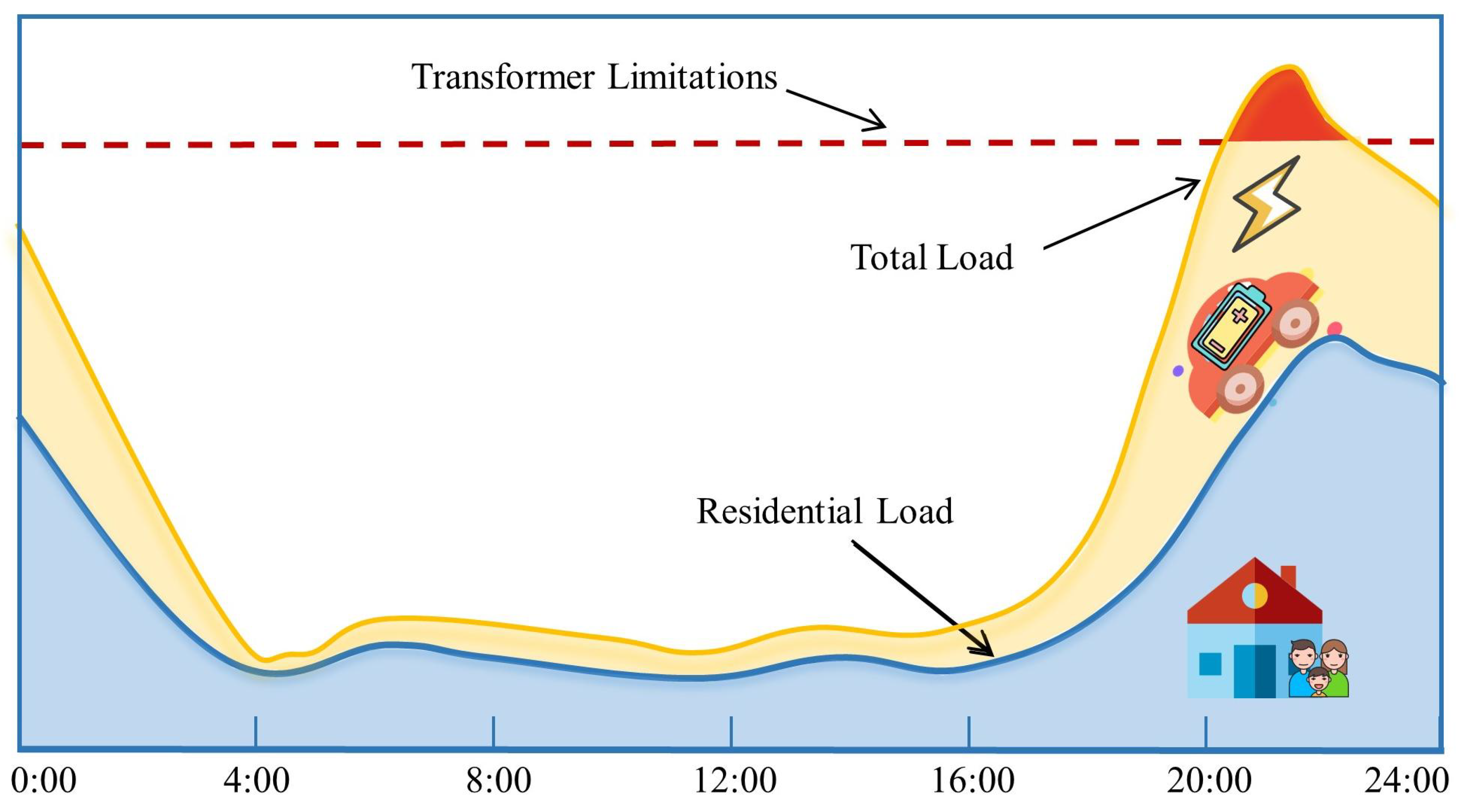

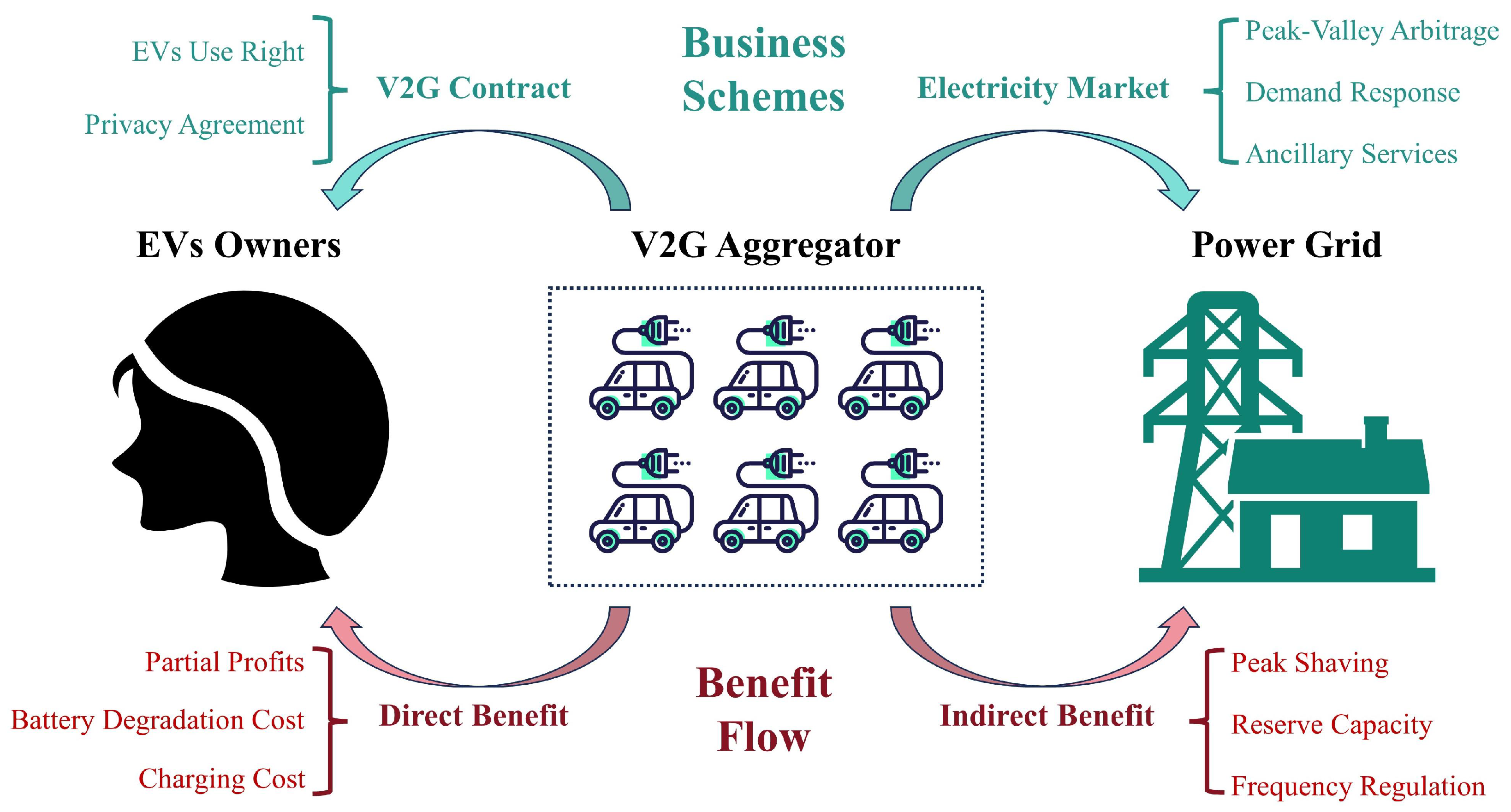

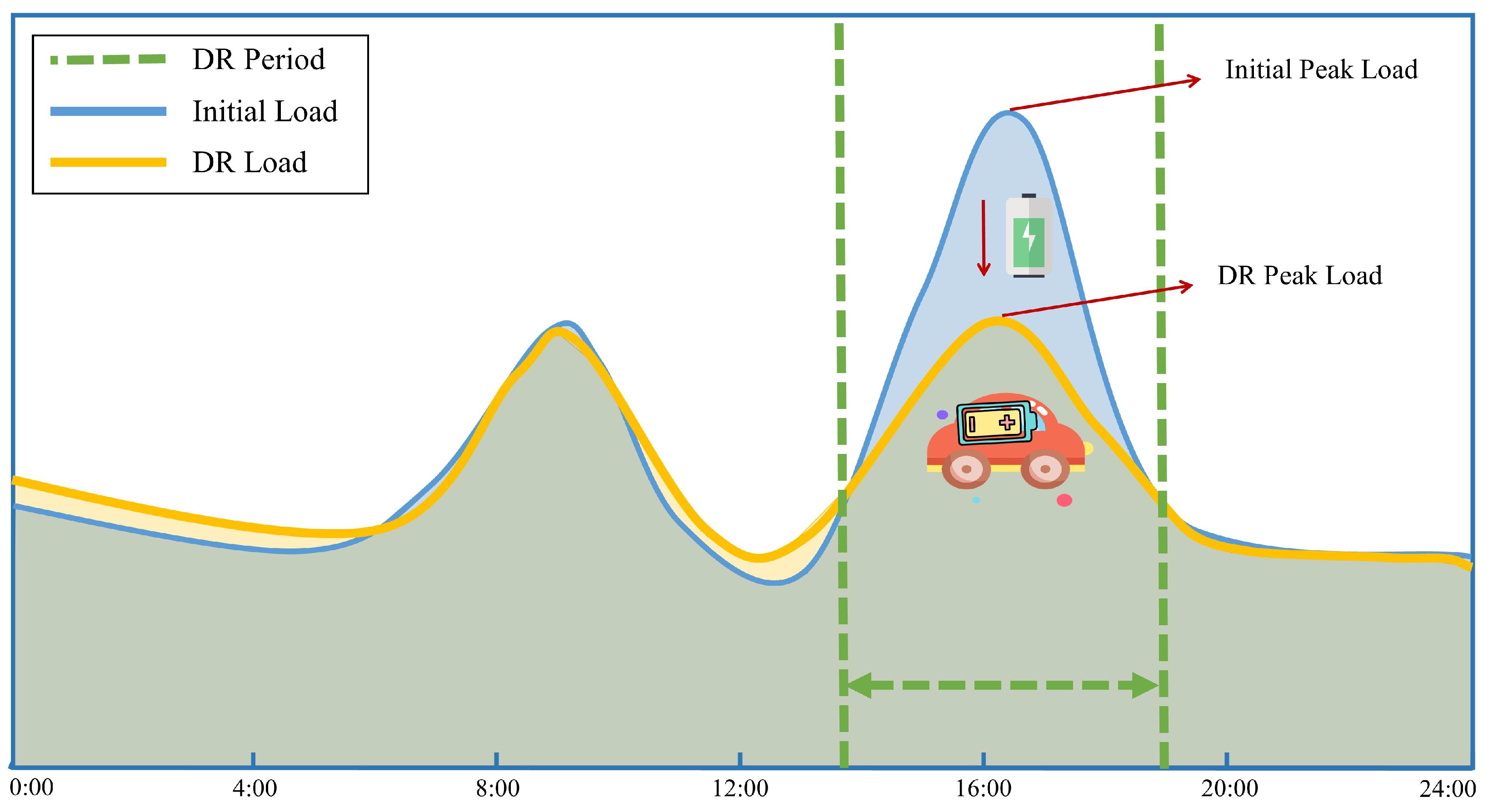
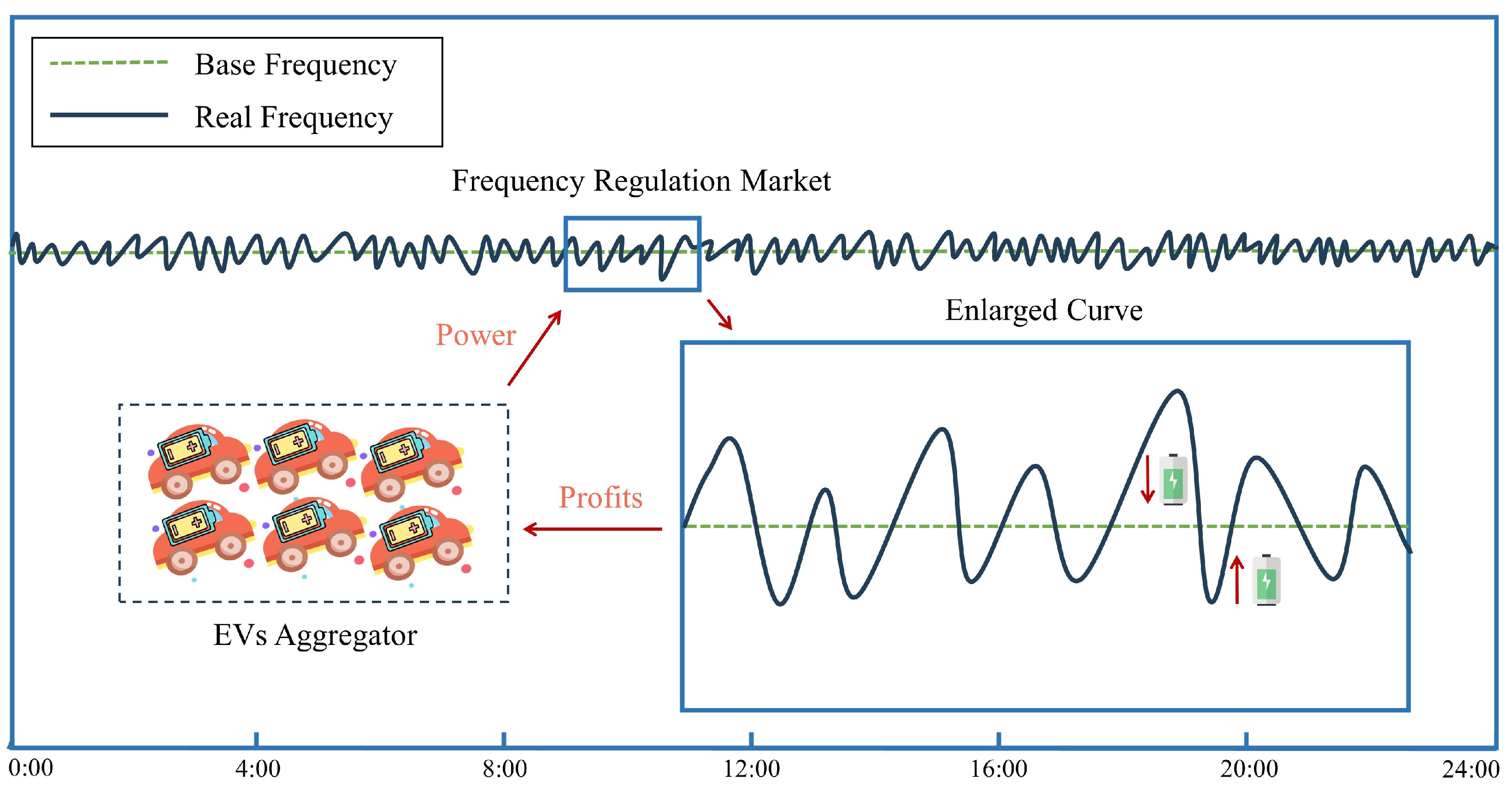
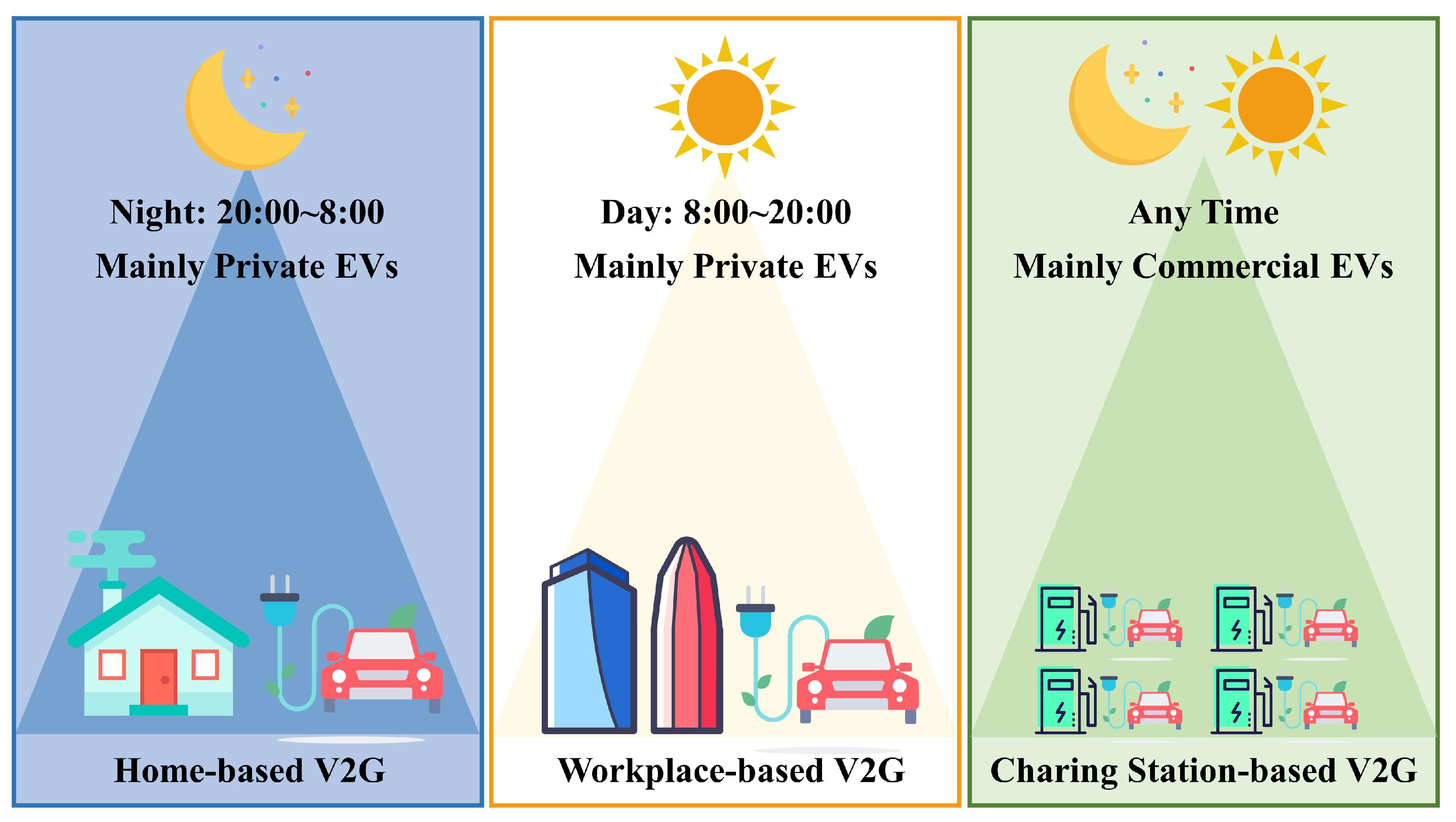
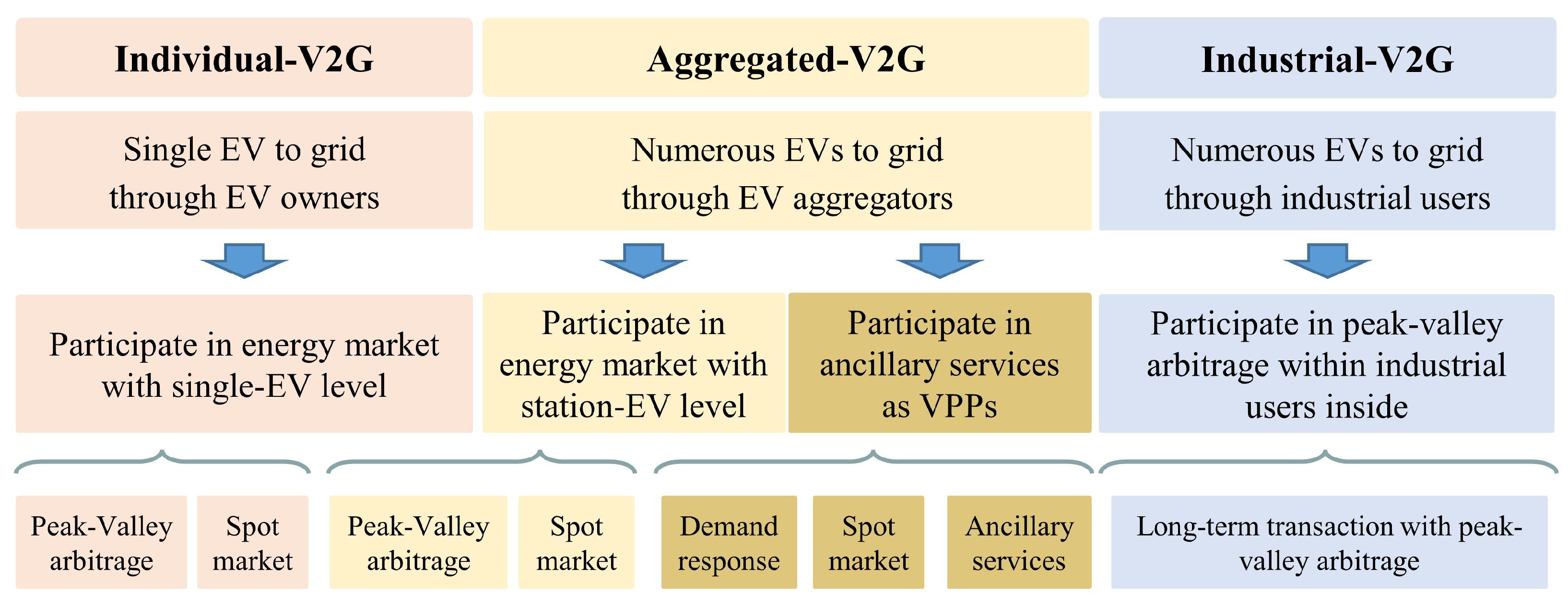
| Region | Numbers | Representation | Country | Year | CPs | Services |
|---|---|---|---|---|---|---|
| Europe | 88 | Powerloop | UK | 2018 | 135 | arbitrage, load shifting, emergency back up |
| Share the Sun | Netherlands | 2019 | 80 | frequency regulation, load shifting | ||
| Bidirectional Lade Management | Germany | 2021 | 50 | frequency regulation, DR, arbitrage, load shifting | ||
| Grid Motion | France | 2017 | 15 | frequency regulation, arbitrage, load shifting | ||
| America | 24 | Smart MAUI, Hawaii | US | 2012 | 80 | load shifting |
| INVENT-UCSD | US | 2017 | 50 | frequency regulation, DR, load shifting | ||
| BC Hydro [86] | Canada | 2023 | unknown | peak shaving, load shifting | ||
| Asia | 14 | Leaf to Home | Japan | 2012 | 4000 | load shifting, emergency back up |
| VGI Core Component Development | Korea | 2018 | 100 | frequency regulation, DR, reserve, load shifting | ||
| Taizhou [87] | China | 2023 | 14 | peak shaving, load shifting | ||
| Wuxi [88] | China | 2023 | 50 | arbitrage, load shifting, emergency back up | ||
| Australia | 3 | Flinders University V2G Trial | Australia | 2023 | 10 | arbitrage, load shifting |
| Africa | 2 | UNDP Windhoek V2G | Namibia | 2019 | 2 | load shifting |
Disclaimer/Publisher’s Note: The statements, opinions and data contained in all publications are solely those of the individual author(s) and contributor(s) and not of MDPI and/or the editor(s). MDPI and/or the editor(s) disclaim responsibility for any injury to people or property resulting from any ideas, methods, instructions or products referred to in the content. |
© 2024 by the authors. Licensee MDPI, Basel, Switzerland. This article is an open access article distributed under the terms and conditions of the Creative Commons Attribution (CC BY) license (https://creativecommons.org/licenses/by/4.0/).
Share and Cite
Wan, M.; Yu, H.; Huo, Y.; Yu, K.; Jiang, Q.; Geng, G. Feasibility and Challenges for Vehicle-to-Grid in Electricity Market: A Review. Energies 2024, 17, 679. https://doi.org/10.3390/en17030679
Wan M, Yu H, Huo Y, Yu K, Jiang Q, Geng G. Feasibility and Challenges for Vehicle-to-Grid in Electricity Market: A Review. Energies. 2024; 17(3):679. https://doi.org/10.3390/en17030679
Chicago/Turabian StyleWan, Muchun, Heyang Yu, Yingning Huo, Kan Yu, Quanyuan Jiang, and Guangchao Geng. 2024. "Feasibility and Challenges for Vehicle-to-Grid in Electricity Market: A Review" Energies 17, no. 3: 679. https://doi.org/10.3390/en17030679
APA StyleWan, M., Yu, H., Huo, Y., Yu, K., Jiang, Q., & Geng, G. (2024). Feasibility and Challenges for Vehicle-to-Grid in Electricity Market: A Review. Energies, 17(3), 679. https://doi.org/10.3390/en17030679






